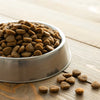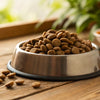Is Wet or Dry Food Better for Dogs with Diarrhea?
- Houndsy
Table of Contents
- Introduction
- Understanding Diarrhea in Dogs
- The Role of Diet in Managing Diarrhea
- Wet Food vs. Dry Food: Which is Better for Diarrhea?
- The Benefits of the Houndsy Kibble Dispenser
- Frequently Asked Questions (FAQs)
- Conclusion
Introduction
Imagine this: it’s a sunny Saturday morning, and you’re ready to take your furry friend for a long-awaited walk. You’re excited and can already picture the wagging tail and joyful barks. But as you open the door, you notice your dog has had an accident on the floor. Diarrhea. Your heart sinks, and suddenly, you're faced with the question: is wet or dry food better for dogs with diarrhea?
Diarrhea is a common issue that many dog owners encounter at some point, and understanding how to manage it effectively is crucial for your pet's health. Recent studies suggest that dietary choices can significantly impact a dog’s gastrointestinal health. The right food can aid in recovery and help maintain overall well-being. By the end of this article, you’ll learn about the best feeding practices for dogs experiencing diarrhea, the differences between wet and dry food, and how to make the most informed choices for your beloved companion.
We will delve into the nutritional aspects, practical feeding strategies, and the underlying causes of diarrhea in dogs. Engaging with this information will empower you to take better care of your pet during these challenging times. So, let’s embark on this journey together and explore whether wet or dry food is the best option for our furry friends when they face digestive troubles.
Understanding Diarrhea in Dogs
What is Diarrhea?
Diarrhea is defined as the frequent passage of loose or watery stools. For dogs, this can manifest as changes in their usual bathroom habits, often occurring suddenly. It can result from various factors, including dietary indiscretion, infections, stress, or underlying health issues. Understanding the cause of diarrhea is essential for determining the appropriate feeding strategy.
Common Causes of Diarrhea
- Dietary Changes: Abrupt changes in diet can upset a dog's digestive system. This is particularly true for sensitive stomachs that require gradual transitions.
- Food Intolerances and Allergies: Many dogs have sensitivities to specific ingredients, such as grains or certain proteins, leading to gastrointestinal disturbances.
- Bacterial or Viral Infections: Infections can cause inflammation of the intestines, resulting in diarrhea.
- Parasites: Intestinal parasites, such as giardia or worms, can disrupt digestion and lead to diarrhea.
- Stress or Anxiety: Just like humans, dogs can experience gastrointestinal upset due to stress, impacting their digestive health.
When to Consult a Veterinarian
If your dog experiences diarrhea, it's essential to monitor their condition closely. You should consult a veterinarian if:
- The diarrhea persists for more than 24 hours.
- There are accompanying symptoms such as vomiting, lethargy, or blood in the stool.
- Your dog shows signs of dehydration (e.g., dry gums, excessive thirst).
Being proactive can prevent more serious health issues down the line.
The Role of Diet in Managing Diarrhea
Should You Withhold Food?
When a dog has diarrhea, many pet owners wonder whether they should withhold food entirely. While fasting can help “reset” the digestive system in some cases, it is not always necessary. Most veterinarians recommend offering small amounts of food after a short fasting period (12-24 hours) to avoid worsening the condition. A bland diet is typically advised during this time.
What is a Bland Diet?
A bland diet usually consists of easily digestible foods that are gentle on the stomach. Common recommendations include:
- Boiled Chicken: Skinless and boneless, boiled chicken is lean and provides essential protein without added fats.
- Plain Rice: White rice is easily digestible and can help firm up loose stools.
- Pumpkin: Canned pumpkin (not the spiced pie filling) is rich in fiber and can help regulate digestion.
This diet should be offered in small, frequent meals to help your dog gradually return to their regular eating routine.
Wet Food vs. Dry Food: Which is Better for Diarrhea?
Now, let’s explore the differences between wet and dry dog food and how each may impact a dog suffering from diarrhea.
Nutritional Composition
-
Wet Food:
- Moisture Content: Wet dog food contains approximately 70-80% moisture, making it a great option for dogs that may be dehydrated due to diarrhea.
- Palatability: The aroma and flavor of wet food can entice dogs to eat, especially if they are feeling unwell.
- Gentle on the Stomach: The soft texture is easier to chew and digest, making it suitable for dogs recovering from gastrointestinal distress.
-
Dry Food:
- Crunchy Texture: The crunchiness of kibble can help with dental health by reducing tartar buildup.
- Convenience: Dry food is easy to portion, store, and serve, making it a practical choice for busy pet owners.
- Long Shelf Life: Kibble has a longer shelf life and does not require refrigeration, making it easy to keep on hand.
Evaluating Effectiveness During Diarrhea
When deciding between wet and dry food for dogs with diarrhea, consider the following factors:
- Hydration Needs: If your dog is dehydrated, wet food can provide essential moisture to help keep them hydrated.
- Digestive Sensitivity: For dogs with sensitive stomachs, wet food may be gentler and easier to digest than dry kibble.
- Preference and Acceptance: Some dogs may prefer wet food, especially if they are feeling unwell. Offering a food they find appealing can encourage them to eat.
Recommendations for Feeding
- Start with a Bland Diet: If your dog has diarrhea, start with a bland diet using boiled chicken and rice or canned pumpkin mixed with a small amount of wet food. Gradually introduce more regular food as their condition improves.
- Monitor for Improvement: Keep an eye on your dog's stools and overall health. If they respond positively to the bland diet, you may consider transitioning back to their regular food.
- Consult Your Veterinarian: If your dog does not improve within a few days or if diarrhea returns, it's crucial to consult with your veterinarian to rule out underlying health issues.
The Benefits of the Houndsy Kibble Dispenser
At Houndsy, we believe that feeding your dog should be a seamless and enjoyable experience. Our flagship product, the Houndsy Kibble Dispenser, elevates the feeding ritual by offering a stylish and practical solution to daily feeding challenges.
Key Features of the Houndsy Kibble Dispenser
- Perfect Portion Control: The convenient crank mechanism allows for perfect portions every time, reducing the risk of overfeeding during recovery from diarrhea.
- Standing Height Design: No more bending down! Our dispenser is designed at a comfortable height, making it easier for pet owners to feed their dogs without straining their backs.
- High-Quality Materials: Made with durable, BPA-free materials, the Houndsy Kibble Dispenser ensures that your dog's food stays fresh and safe.
- Stylish Aesthetic: With a mid-century modern design, our dispenser not only functions beautifully but also complements your home decor.
If you’re looking to enhance your dog feeding experience while maintaining elegance in your space, consider exploring the Houndsy Kibble Dispenser.
Frequently Asked Questions (FAQs)
1. Can I feed my dog both wet and dry food?
Yes, many dog owners choose to mix wet and dry food to provide a balanced diet that combines the benefits of both types. Wet food can enhance hydration while dry food supports dental health.
2. What should I do if my dog refuses to eat?
If your dog is hesitant to eat, try warming the wet food slightly to enhance its aroma. You can also mix in some of their favorite treats or add a small amount of broth to make it more enticing.
3. How long should I feed my dog a bland diet?
Typically, a bland diet should be fed for 3-5 days after the diarrhea has resolved. Gradually reintroduce their regular food during this period, monitoring for any signs of recurrence.
4. How can I prevent diarrhea in my dog in the future?
Regularly monitor your dog’s diet and avoid sudden changes. Ensure they have access to fresh water, maintain a consistent feeding schedule, and consult your veterinarian for any dietary concerns.
5. When should I take my dog to the vet for diarrhea?
If diarrhea persists for more than 24 hours or is accompanied by additional symptoms like vomiting, lethargy, or blood in the stool, you should contact your veterinarian for further evaluation.
Conclusion
Navigating your dog’s health can be a daunting task, especially when faced with diarrhea. Understanding the differences between wet and dry food, along with the importance of a bland diet, can empower you as a pet owner to make informed decisions that promote your dog’s well-being.
As we’ve explored, wet food often provides hydration and is easier to digest, making it a strong contender for dogs dealing with diarrhea. However, dry food also has its advantages in terms of convenience and dental health. By observing your dog's preferences and needs, you can tailor their diet for optimal health.
Don’t forget to elevate your dog feeding experience with the Houndsy Kibble Dispenser, designed for convenience and style. Remember, your dog's health is paramount, and with the right approach to their diet, you can help them feel their best.













